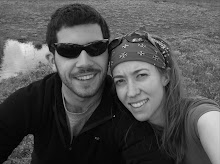Well, I suppose we´ve hidden his existence long enough. Jess and I think it´s time to introduce you all to the newest inhabitant of our house. Friends and family, meet Yoda:
We know, we know. You all are thinking how silly it is to end up with another pet when we only have 8 months left in
Jess and I both work at the Casa Materna outside of town on a regular basis. I think we´ve explained the Casa Materna in past blogs, but for those who are new here´s a brief description. 
A bunch of Nicaraguan women came up with the idea to have very low cost lodging available within a short distance of hospitals, where rural women could go a week or two before their delivery date to basically wait. The Somoto Casa Materna is one of the area´s best, as the lodging and food are completely free. The actual building is also located about a 2 minute drive from the hospital, so as soon as a woman goes into labor an ambulance is sent to bring her right in. Also, as our Casa Materna is managed by the Ministry of Health, there is a nurse at the CM 24 hours a day. Overall, it´s a great idea.
The CM also is a great place for Peace Corps volunteers, where we can go to speak to several women at once about maternal health, child nutrition, and the importance of family planning in the future. We have a lot of women come through the Casa Materna, but unfortunately, plenty still give birth in the home. Their reasons vary, but unfortunately the two most prominent are a general distrust in government services and a machismo attitude by the fathers and husbands. Jess and I have actually had conversations with men who say, “I don´t want some doctor looking at my wife´s private parts. Those are for me only.” So, you can see that we still have a long way to go.
What does this have to do with Yoda, our new housemate? Well, apparently the benefits of the Casa Materna are evident across species. Yoda´s mom came to the Casa Materna sometime in May and not being able to use the services at the hospital, understandably, chose to give birth to her litter of kittens right there on the Casa Materna grounds. We´re not sure how many were born or how many are still alive, but we first met Yoda when he must have been only a few weeks old. Jess and I were at the Casa Materna dropping off a mural when Astro pointed us to a wooden shack on the property. Inside the shack was Yoda, all by himself, and not at all interested in playing with “the white giant” drooling in front of him. We went home alone that day and prepared for our visit to the States. As Jess was making her rounds post-vacation, she came across Yoda again, not much bigger than the first time we saw him and covered in fleas. EVEN THEN, she was able to restrain herself another week and let him be at the Casa Materna. The next week, however, when Jess made it back to the Casa Materna, the nurses informed her that they had to do something with the cat because it was too dirty and annoying to keep around. That´s never a good sign in
We went home alone that day and prepared for our visit to the States. As Jess was making her rounds post-vacation, she came across Yoda again, not much bigger than the first time we saw him and covered in fleas. EVEN THEN, she was able to restrain herself another week and let him be at the Casa Materna. The next week, however, when Jess made it back to the Casa Materna, the nurses informed her that they had to do something with the cat because it was too dirty and annoying to keep around. That´s never a good sign in
Jess cleaned him up using Astro´s anti-flea shampoo: By the way, his name comes from this photo, if you can't see the resemblance.
By the way, his name comes from this photo, if you can't see the resemblance.
Here he is next to a pineapple, for size comparison. We weighed him a couple of days later and he came in just under 
So, now we´ve had him for about a month, and while he´s grown, it isn´t much. Every day he gets a little more bold, exploring our backyard and the property next door. Astro has been great about sharing his food and his family, and they are just getting to point where you could call their interaction “playful.” Here is a photo montage of Astro's opinion of his new foster brother:
Welcoming a new family member to the house that is of a different species and 1/50th your size....confusing.
Sharing your food and water...unsettling.
Realizing that you have a common bond of abnormally large appetites...
So, that´s our new friend. More interesting things to come soon!




